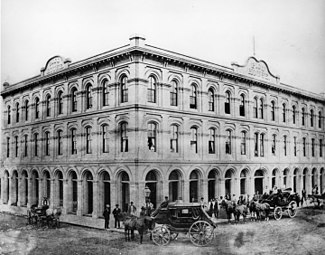Pico House
|
Pico House
|
|

(1875)
|
|
| Location | Los Angeles, California |
|---|---|
| Coordinates | 34°03′21.75″N 118°14′22″W / 34.0560417°N 118.23944°WCoordinates: 34°03′21.75″N 118°14′22″W / 34.0560417°N 118.23944°W |
| Built | 1869–1870 |
| Architect | Ezra F. Kysor |
| Architectural style | Victorian |
| Part of | Los Angeles Plaza Historic District (#72000231) |
| CHISL # | 159 |
| Designated CP | November 3, 1972 |
The Pico House is a historic building in Los Angeles, California, dating from its days as a small town in Southern California. Located on 430 North Main Street, it sits across the old Los Angeles Plaza from Olvera Street and El Pueblo de Los Angeles Historic Monument.
Pío Pico, a successful businessman who was the last Mexican Governor of Alta California, ordered construction of a luxury hotel in the growing town. The architect was Ezra F. Kysor, who also designed the Cathedral of Saint Vibiana, and it was constructed between 1869 and 1870. The resulting Italianate three story, 33-room hotel, dubbed Pico House (or Casa de Pico) was the most extravagant and lavish hotel in Southern California, and its opening was cause for much celebration. It had a total of nearly 80 rooms, large windows, a small interior court, and a grand staircase. In the days of the hotel's primacy the courtyard featured a fountain and an aviary of exotic birds. The structure forms three sides of a trapezoid whose open end immediately abuts the adjacent Merced Theatre, thus forming the courtyard. The back of the hotel faces Sanchez Street, where the large gate used by supply wagons and other large vehicles can still be seen.
Its time in the spotlight did not last very long. By 1876, the Southern Pacific Railroad had linked the city with the rest of the country and more residents and businessman began pouring in. Pio Pico himself started having financial troubles, and lost the hotel to the San Francisco Savings and Loan Company.
In 1882, the hotel was so crowded with guests that Manager Dunham secured 30 rooms on the opposite side of the street, "and still the cry is more room."
The business center of the city began to move south and, by 1900, the building began to decline. After decades as a shabby lodging house, it finally passed into the hands of the State of California in 1953, and it now belongs to the El Pueblo de Los Angeles State Historic Monument. Parts of this building were renovated in 1981 and 1992. The ground floor is occasionally used for exhibits and other events.
...
Wikipedia



